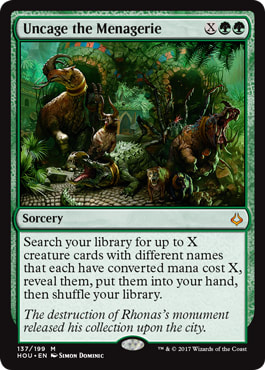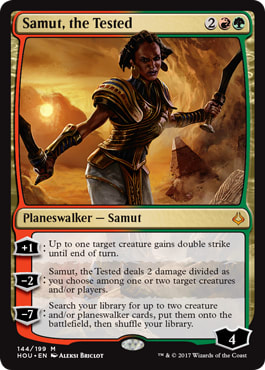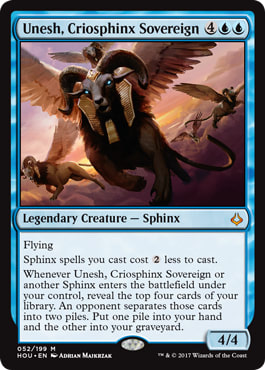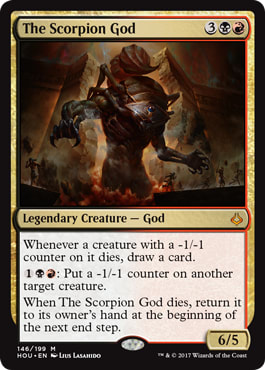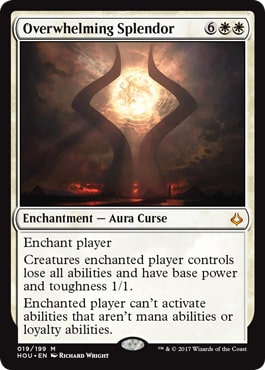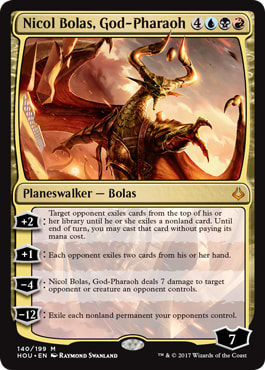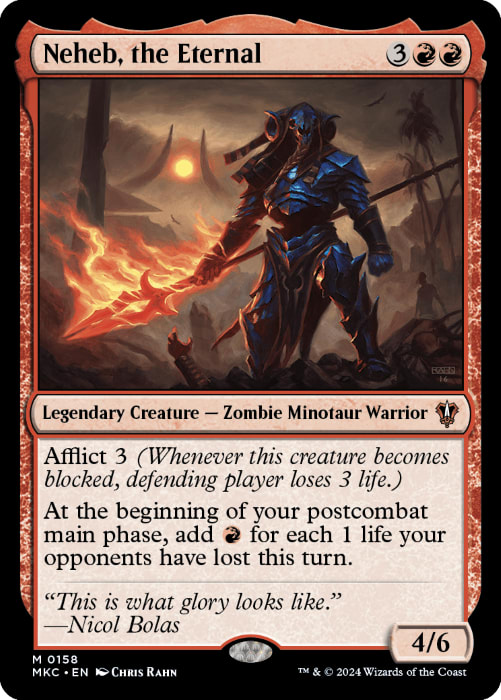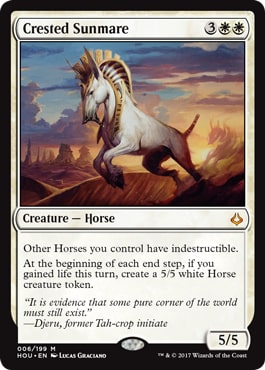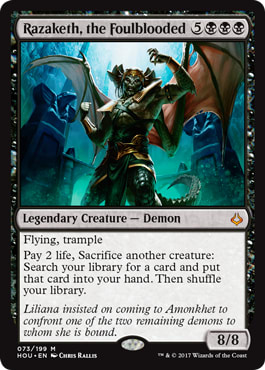Amonkhet was a dark setting compared to Kaladesh, starting somewhat hopeful and light with Gideon being taken by Oketra and the beauty of the plane. However, this quickly went south when death and betrayal were key elements of the world's culture. The people of Amonkhet patiently awaited the return of their mighty god-pharaoh and oh boy did he come back. Nicol Bolas came to Amonkhet in Hour of Devastation and the people realized just how deadly their god-pharaoh truly was. This set boasts some interesting mythics that we're going to rank and discuss, so let's get right to it!
12. Majestic Myriarch
Right off the bat we've got quite the stinker. On paper, Majestic Myriarch reads pretty decently, enabling you to get a fairly big creature that can get all manner of keywords on it. The problem is that it's an awful top deck and has a floor so low it's atrocious. Consider this situation: your opponent board wipes you while you have no cards in your hand. You draw this and play it. Congratulations, you've just played a five-mana vanilla 2/2. It has the potential to hit fairly hard, but at that point you could be playing other cards that are for more interesting than this.
11. Uncage the Menagerie
Cards that let you pull a bunch of different cards at once is cool, but the problem is that it's difficult to scale properly. For example, paying X = 1 means you're paying three mana for a single one mana creature. Yikes. X = 2 or 3 is probably somewhat reasonable, but past that, you're not likely to have the density of creatures needed to pull that many from - even in Commander. The card has seen very little play anywhere and, while a neat concept, just isn't all that great.
10. Samut, the Tested
The first Samut card in Amonkhet wasn't exactly the greatest, but it did have a home in Commander as it made for a very reasonable Commander. This planeswalker iteration doesn't have that luxury, and the combination of abilities here ultimately made for a fairly weak planeswalker as a result. Getting to ultimate Samut, the Tested rules, but odds are you'll never make good enough use of her abilities to get there without the aid of Doubling Season.
9. Unesh, Criosphinx Sovereign
Frankly, Unesh is pretty cool to see happen. Sphinxes have been a mainstay of Magic
for years and have become one of Blue's core - or "iconic" - creature types over those years. As such, it makes sense that there would be a sphinx kindred legend to give you the opportunity to make the sphinx deck of your wildest dreams. The problem is that most sphinx cards aren't all that great on their own to warrant building a deck around and Unesh doesn't really give you a good reason to put them together in a single shell. Cool card, but needed some work on the execution.
8. The Scorpion God
The other two "Grixis Gods" of this set are packing some really powerful effects that players have continued to gravitate to for years and years. Spoiler alert - those may be topping out this list they're so beloved. Unfortunately, The Scorpion God seems like the Black sheep of the bunch, requiring three mana for what usually amounts to a light poke and the massive impact of the other two cards. Sure you can draw some cards, but it's just not as powerful as it wants to be. Cool design, but the others are far better.
7. Overwhelming Splendor
In terms of sheer power level and grossness, Overwhelming Splendor easily takes the cake for the most vile card in this set. If you've been around Magic circles for a respectable length of time, you're no doubt heard all the horror stories about what the card Humility does to games. Well, what if we made it really expensive but it only impacts one single player? Screw that person in particular. I'd give this one higher points than some of these cards for playability, but it's just not fun for the majority of people in most games it shows up in.
6. Nicol Bolas, God-Pharaoh
For many players, there was this eager anticipation over what the new Bolas would do when it was revealed that he would essentially be the face of this set. After all, his first two cards - Nicol Bolas and Nicol Bolas, Planeswalker - were arguably two of the most iconic cards of all time. So did this one live up to its expectations? Not really. This version of the iconic villain had a minor showing in Standard with small numbers in various lists, but saw stronger popularity in Commander as time went on.
5. Neheb, the Eternal
As is a bit of a trend with this set, Neheb wasn't a big card in competitive circles. Players absolutely adored the card when it comes to Commander, though. It's not difficult to dish out a ton of damage and make absurd amounts of mana as a result. You can then chain this into multiple extra combat phases to do even more damage and accumulate even more mana for even more beatings. Right now, this is the second most played Commander card and it's not hard to see why, though it took a little while to reach that point which knocks it down a few pegs..
4. Crested Sunmare
If ever there was a card destined for casual greatness, it's Crested Sunmare. If you build around it, it generates absurd amounts of powerful creatures that are difficult to deal with. When Soul Warden and friends are some of the most popular Commander cards out there - combined with the horse typeline as well - it's not hard to see why people love it. The card broke out and was a massive hit, as well as being a stone cold bomb in Limited if you had any kind of life gain access.
3. Razaketh, the Foulblooded
When Avacyn Restored came out, Griselbrand completely changed the fabric of the game. He was banned from Commander in just over a month and immediately had a monstrous impact on formats like Modern and Legacy due to the ease of cheating it into play. Now we get Razaketh, and instead of drawing seven random cards, you can pay just a couple life and a creature to Demonic Tutor for whatever you need. The card has proved extremely powerful in multiple formats as a result and is easily one of the most absurd powerhouses for very specific kinds of decks.
2. The Locust God
The Locust God is about as much of a fan favorite as I can think of, and one that anyone who isn't a fan loves to hate. In truth, the card never saw much competitive play during its initial run in Standard. However, Commander players love drawing cards and making tokens, and as you can imagine it was an instant hit. Players everywhere loved it at the helm of their Izzet lists or else jammed it happily in the 99. Even more notable is that it would even find a home later in certain Pioneer Indomitable Creativity lists as it can go infinite with Sage of the Falls.
1. The Scarab God
Few cards have been so wildly dominant without feeling absolutely busted as The Scarab God. Its solid body, intense difficulty to remove, and cheap means of bringing back all manner of creatures made it an absolute staple of Standard in its era. If you were playing Blue and Black in any deck, you were almost certainly running this bad boy on the top end. Amazingly, I'd say The Locust God has outshone it to modern sensibilities thanks to Commander, but this one easily deserves top billing for just how much of a menace it was during its Standard tenure.
Paige Smith
Twitter: @TheMaverickGal
Twitch: twitch.tv/themaverickgirl
YouTube: TheMaverickGal

















